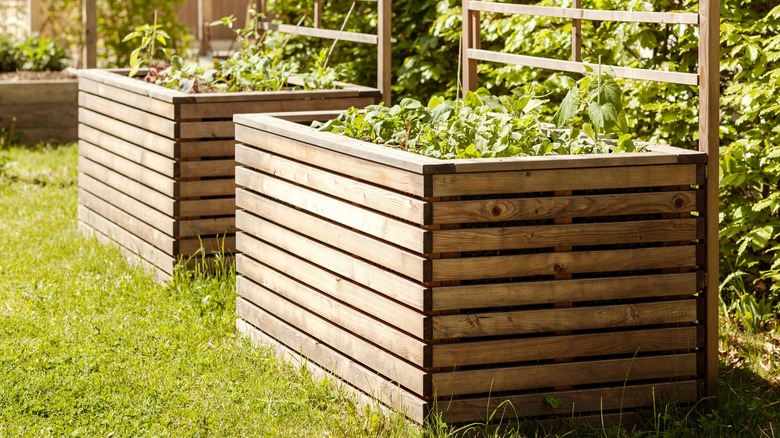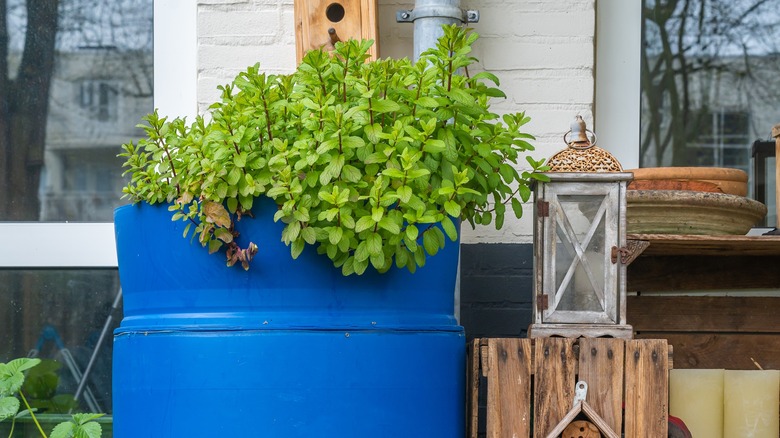The Affordable DIY Alternative To Raised Garden Beds You Need To See To Believe
Green thumbers all know that some plants do better grown in raised garden beds as opposed to the ground. There are no mattresses involved; a raised bed simply involves planting on an artificially heightened patch of land beyond the natural terrain level. Numerous benefits come with raised beds, but it can be a cost issue because you have to purchase more soil to construct the beds in the first place — and that doesn't come cheap. You would be spending hundreds buying soil, stones, or wood to erect the bed and maybe hire someone to build it for you. Instead, you can opt for a DIY self-watering container that does the same work as a raised bed while being so much more affordable. You would only need some old buckets, used milk jugs, and a PVC pipe for $13 at Home Depot.
Gardens need soil with great drainage capabilities, which is one of the benefits raised beds provide. You'll also bypass negative soil conditions, such as too much clay. Having raised beds also does wonders for your back problems. You don't have to bend over to reach the ground anymore when you have higher inches of earth to work on. However, raised garden beds are costly to erect, permanently locked into their location, and immobile. They also tend to dry out faster than normal ground soil. Self-watering tubs are better alternatives to raised garden beds because you let the plants water themselves — removing the threat of over- or underwatering them.
Put together the self-watering container by drilling holes where necessary
Self-watering tubs are lifesavers for people with limited space to plant in their yards and who can't remember all the watering routines. The plants routinely suck up the water that they need without your intervention. The way that they do this is through capillary action.
To set up your self-watering planter, you need a tub and some old milk jugs to sit at the bottom. The larger the base, the more jugs you'll need, but only 80% of the bottom should be covered with the jugs, so the soil takes up the rest of the space. Keep all jugs capped except one. Drill a hole 5 inches from the bottom of the tub and two holes on the tops and bottoms on all four sides of each milk jug. Then, pull out that PVC pipe and cut it so 2 inches stick out above the tub. Be sure to cut it at an angle for easy passage of water. Now, stick the angled end into the uncapped jug, and your contraption is ready.
Finally, load in the soil until it reaches just below the top holes on the milk jugs. You can grow your plants above these jugs and hydrate them by pouring in water through the pipe. The open jug will dissipate the water into the other jugs and surrounding soil. As the plants become thirsty, they'll take up only as much water as they need.
Check the tub hole to know when to add water
With the self-watering tub, you must know when the water reservoir system is running dry so you can give your garden a nice drink. Even if the water pipe overflows, the real litmus test is water flowing out of the tub's hole. Check the hole in the tub to see if water is dripping from it. If yes, it's full. If not, give it some time, add more water, and then check again.
The capillary action of the system ensures that the plants only siphon what they need to subvert root rot or drowning. You don't have to worry about overwatering. Another win is that, since the bottom of the container is waterlogged, creepy crawlies will steer clear. Fewer pests mean fewer headaches about the health of your plants.
The fact that all the water is pooled at the bottom means that the topsoil is a lot less moist. This amounts to fewer weeds as well. Harvesting fruits and veggies will become much easier, especially root tubers like potatoes. The tubs are also portable. As for the cons of this device, it may not be so cost-effective if you're spending money on soil. While you could just use compost or fertilizer and soil from your yard, bagged soil is less likely to have weed seeds and pests. Also, you have limited space to plant as much as you would want than if you were using the ground.

